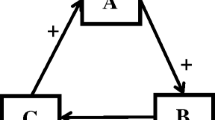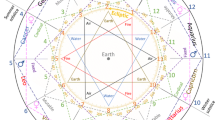Abstract
The respondent agrees with William Grassie that many windows on nature are possible; that emphasis must remain on the generation of order; that “chance” would better be recast as “contingency”; and that the ecological metaphysic has wide implications for a “politics of nature”. He accepts the challenge by Pedro Sotolongo to extend his metaphysic into the realm of pan-semiotics and agrees that an ecological perspective offers the best hope for solving the world’s inequities. He replies to Stanley Salthe that he now agrees that the second law of thermodynamics is the overarching law of nature, but only when the duality inherent in of the concept of entropy is widely recognized. The respondent is enthusiastic over Jeffrey Lockwood’s extrapolation of process ecology to include the concept of “species” and over John Haught’s description of how the construct paves the way for a “theology of evolution” by recasting evolution as an unfolding “drama”.
Similar content being viewed by others
Notes
Relativistic effects at the scales of biology appear negligible.
Systems engineers often talk about “driving” a model via temporally varying boundary circumstances.
In keeping with the Newtonian exclusion of the observer, the boundary problem has been marginalized and the focus of causality has been fixed upon the constraint of law.
Many biologists will object that the process approach ignores the material universality of DNA in life processes. While DNA/RNA does appear to be common to all life on earth, it is questionable whether it was always ubiquitous. Deacon (2006), for example, argues how molecular genomes could have evolved for dynamical reasons out of pre-existing configurations of early biochemical processes and became universal only after displacing earlier, less effective forms of memory.
Perpetual harmonies inevitably remind one of Thielhard de Chardin’s Omega Point. Not that it is easy to imagine what could possibly be the harmonious outcome of this chaotic dissipative structure called human society, but more importantly, that, as I mentioned in the last sentence of 3W, pessimism is no longer the only attitude possible.
The conundrum over “dark” energy and matter prompts the speculation that one or more additional forces may be at work in the cosmos and remain to be formulated in terms of new law.
Data show that most ecosystems cluster around a ratio of 60% dissipation versus 40% effective work (Ulanowicz 2009b).
Rosen’s entailment does not apply to other forms of causality—material, formal or final.
References
Ayala FJ (2009) Darwin’s revolution. Presented at biological evolution: facts and theories. Pontifical Gregorian University, Rome, 3 March
Bickhardt MH, Campbell DT (1999) Emergence. In: Andersen PB, Emmeche C, Finnemann NO, Christiansen PV (eds) Downward causation. Aarhus University Press, Aarhus, pp 322–348
Chaisson EJ (2001) Cosmic evolution: the rise of complexity in nature. Harvard University Press, Cambridge
Deacon TW (2006) Reciprocal linkage between self-organizing processes is sufficient for self-reproduction and evolvability. Biol Theory 1(2):136–149
Deacon TW (2011) Incomplete nature. W.W. Norton & Co., New York
Depew DJ (2011) Accident, adaptation and teleology in Aristotle, Empedocles and Darwinism. In: Auletta G, Leclerc M, Martinez RA (eds) Biological evolution: facts and theories. Gregorian and Biblical Press, Rome, pp 461–478
Haught JF (2000) God after Darwin: a theology of evolution, 2nd edn. Westview, Boulder
Hoffmeyer J (2008) Biosemiotics: signs of life and life of signs. University of Scranton Press, Scranton
Holling CS (1978) The spruce-budworm/forest-management problem. In: Holling CS (ed) Adaptive environmental assessment and management. International series on applied systems analysis, vol 3. Wiley, Hoboken, NJ, pp 143–182
Jørgensen SE (2002) Integration of ecosystem theories: a pattern. Ecol Environ 3:365–396
Juarrero A (1999) Dynamics in action: intentional behavior as a complex system. MIT Press, Cambridge
Lietaer B (2001) The future of money. Century, London
Lietaer B, Ulanowicz RE, Goerner SJ (2009) Options for managing a systematic bank crisis. Sapiens 1(2):1–15
MacArthur RH (1955) Fluctuations of animal populations and a measure of community stability. Ecology 36:533–536
Odum EP (1977) The emergence of ecology as a new integrative discipline. Science 195:1289–1293
Pecci V (1891) Rerum Novarum: on capital and labor. Encyclical of Pope Leo XIII. http://www.papalencyclicals.net/Leo13/l13rerum.htm
Popper KR (1990) A world of propensities. Thoemmes, Bristol
Prigogine I (1978) Time, structure and fluctuations. Science 201:777–785
Rosen R (2000) Essays on life itself. Columbia University Press, New York
Tiezzi E (2006) Steps towards an evolutionary physics. WIT Press, Southampton
Ulanowicz RE (1995) Ecosystem trophic foundations: Lindeman exonerata. In: Patten BC, Jorgensen SE (eds) Complex ecology: the part-whole relation in ecosystems. Prentice Hall, Englewood Cliffs, pp 549–560
Ulanowicz RE (1997) Ecology, the ascendent perspective. Columbia University Press, New York
Ulanowicz RE (1999) Out of the clockworks: a response. Estuaries 22:342–343
Ulanowicz RE (2004) Ecosystem dynamics: a natural middle. Theol Sci 2(2):231–253
Ulanowicz RE (2009a) Increasing entropy: heat death or perpetual harmonies? Des Nat Ecodyn 4(2):1–14
Ulanowicz RE (2009b) The dual nature of ecosystem dynamics. Ecol Model 220:1886–1892
Ulanowicz RE (2011) Towards quantifying a wider reality: Shannon Exonerata. Information 2:624–634
Ulanowicz RE, Hannon BM (1987) Life and the production of entropy. Proc R Soc Lond Ser B 232:181–192
Ulanowicz RE, Goerner SJ, Lietaer B, Gomez R (2009) Quantifying sustainability: resilience, efficiency and the return of information theory. Ecol Complex 6:27–36
Wheeler JA (1980) Beyond the black hole. In: Woolf H (ed) Some strangeness in the proportion. Addison-Wesley, Reading, pp 341–375
Wojtyla K (1988) Letter of His Holiness John Paul II to George V. Coyne, 1 June 1988
Zorach AC, Ulanowicz RE (2003) Quantifying the complexity of flow networks: how many roles are there? Complexity 8(3):68–76
Acknowledgments
I am exceedingly grateful to Editor Roberto Poli for suggesting this format for discussing the ideas I advanced in my latest book. I am also most indebted to the five commentators for their queries, challenges and bold extrapolations. The considerable time that each devoted to reading and commenting is most appreciated. I hope it will become evident to anyone reading my reactions how instrumental their contributions have been towards helping to open yet wider the Third Window.
Author information
Authors and Affiliations
Corresponding author
Rights and permissions
About this article
Cite this article
Ulanowicz, R.E. Widening the Third Window. Axiomathes 22, 269–289 (2012). https://doi.org/10.1007/s10516-011-9181-9
Received:
Accepted:
Published:
Issue Date:
DOI: https://doi.org/10.1007/s10516-011-9181-9




